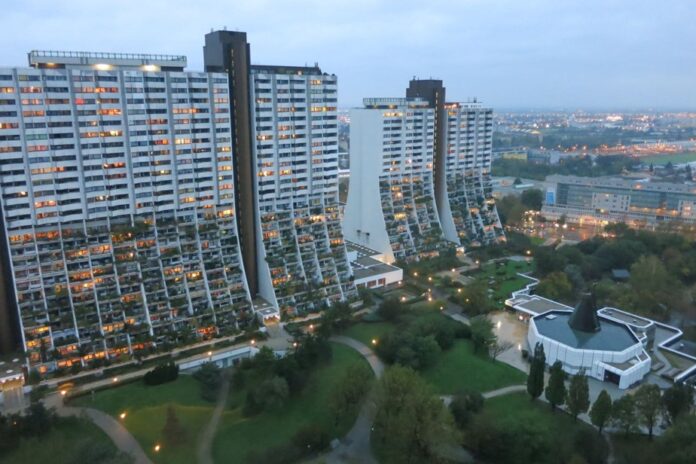(Vienne) Visiting the mecca of social housing, Valérie Plante said Montrealers were ready to accept more density to facilitate the creation of affordable housing.
The mayoress of Montreal will not return from her European tour with the intention of housing 60% of the population in state-funded projects, as is the case in the Austrian capital. But she hopes to convince Quebec and Ottawa to invest more to get a little closer.
“The context is different, we have to adapt that to our reality. But at the same time, I refuse to say: it’s the same, so it stays the same. I refuse that, it’s out of the question,” she said Wednesday afternoon.
One of the ingredients of the Viennese recipe for displaying 420,000 homes owned directly by the state or by state-supported non-profit corporations? Dense projects, where land use is maximized. In the early afternoon, Ms. Plante visited the Biotope City project, a new mixed neighborhood of 1,000 housing units erected on the site of a seven-hectare former Coca-Cola distribution center. Even denser than Griffintown, with rooftop pools and underground parking lots. A large 12-storey bar occupies the center of the field.
“Density is important, especially when doing transit oriented (TOD) areas. She is important,” Ms. Plante said. “I don’t feel that Montrealers are allergic to density. Absolutely not. […] You have to do it intelligently and respecting a certain built environment. »
Valérie Plante had traveled to Vienna with a small delegation from Montreal: the Popular Action Front in Urban Redevelopment (FRAPRU), the Work Unit for the Implementation of Student Housing (UTILE) and the real estate developer Prével were there. part. Sherbrooke Mayor Évelyne Beaudin was also there. Objective: to import solutions to the housing crisis in Quebec.
“The housing crisis is such that we cannot afford to keep the same strategies and meet the same walls,” Ms. Plante said. She pointed out that Vienna levies an income tax of around 0.5% to finance housing – the city is also a “province” (land) of the Austrian federal state.
The hundreds of barricaded housing units of the Office municipal d’habitation de Montréal (OMHM) are “an aberration”, added the mayor.
Despite the gap between Montreal and Vienna – where the stock of social and affordable housing has been built for a century – the two cities have more similarities than it seems on this level, underlined Laurent Lévesque, of UTILE .
“Quebec is one of the places in the world where you are closest to the infrastructure that it takes to achieve the Viennese model,” he said. “Of course we don’t have a housing stock of 400,000 or 500,000 off-market housing units”, but the network of municipal housing offices and that of housing cooperatives are already in place.
The director general of the City of Montreal, Serge Lamontagne, was amazed to see a neighborhood under construction already served by a tram line. A normal scenario in Vienna, where the realization of collective projects (public transport, parks, schools, etc.) is prioritized over housing so that the first residents move into an already complete district.
“I’m in love with the tram,” said general manager Serge Lamontagne of his visit, before turning to the reality of Montreal. “If we want to develop the racecourse, that’s how we’re going to get there, with a structuring transport project. So a tram to the racetrack? “A structuring project,” he repeated, smiling.
“There is no more beautiful mode of transport than the tram to develop urbanity, added Laurence Vincent, from Prével. It is a beautiful tool that unfortunately has been neglected over time. »
The possibility of a tram penetrating the immense land to connect all its inhabitants to the Namur metro station had already been mentioned in a version of the project dating from 2008.


















